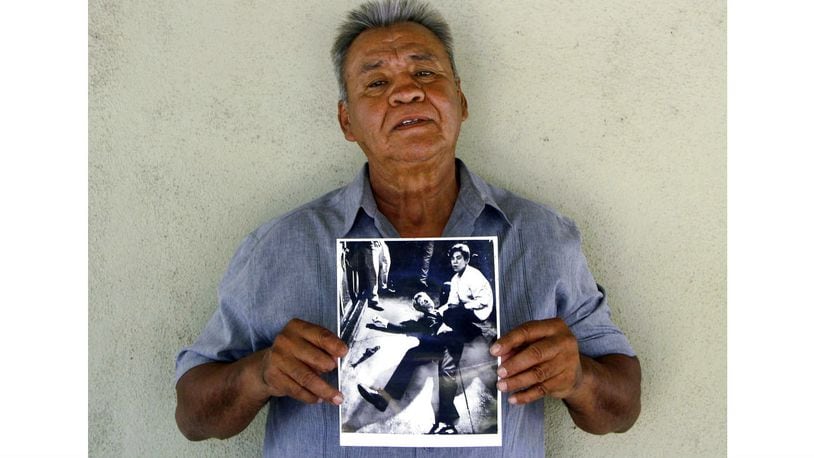Romero was a 17-year-old busboy at the Ambassador Hotel in Los Angeles on June 3, 1968, when he met Kennedy, who had ordered room service. The Mexico native told the Times in 1998 that Kennedy had shaken his hand firmly that night and had looked at him with respect.
"I remember walking out of that room feeling 10 feet tall, feeling like an American," Romero said.
By the next night, Romero was cradling the head of the dying presidential candidate, who was gunned down in the hotel’s pantry moments after winning the California Democratic primary. The teen, who, like Kennedy, was Roman Catholic, pulled his own rosary beads from his pocket and placed them in Kennedy’s hand.
Kennedy died at a hospital early June 6, about 26 hours after being shot.
Credit: Boris Yaro/Los Angeles Times via AP
Credit: Boris Yaro/Los Angeles Times via AP
Romero recalled the hectic atmosphere of the hotel pantry for NPR's StoryCorps in June, as the nation observed the 50th anniversary of Kennedy's assassination. As aides led Kennedy through the kitchen following his victory speech in the nearby ballroom, Romero said he rushed to congratulate the senator.
"I remember extending my hand as far as I could, and then I remember him shaking my hand," Romero told StoryCorps. "And as he let go, somebody shot him."
The shooter, Sirhan Sirhan, a 24-year-old Palestinian immigrant, was tackled by bystanders, who pinned him against a steam table and wrestled his revolver away from him. Five other people were wounded in the shooting, but all of them survived.
Sirhan was later convicted of Kennedy’s murder and sentenced to life in prison.
As Sirhan was held down on the table nearby, Romero tended to the fallen Kennedy.
"I kneeled down to him and I could see his lips moving, so I put my ear next to his lips and I heard him say, 'Is everybody OK?'" Romero said in June. "I said, 'Yes, everybody's OK.' I put my hand between the cold concrete and his head just to make him comfortable."
Listen to Romero recall Kennedy’s assassination on StoryCorps below.
Photos of that moment, shot by photographers from Life magazine and the Los Angeles Times, became the most iconic imagery of Kennedy’s assassination.
Romero said he could feel Kennedy’s blood, coming from a bullet wound behind Kennedy’s right ear, streaming through his fingers.
"I remember I had a rosary in my shirt pocket and I took it out, thinking that he would need it a lot more than me," Romero said. "I wrapped it around his right hand and then they wheeled him away."
The following morning, Romero went to school as usual. He tried to forget the horrific images from the night before, but a woman sitting near him on the bus recognized him from photos in the newspaper.
As she asked if that was him, Romero said, he looked down at his hands. His fingernails were still stained with the senator’s blood.
The assassination haunted Romero for the rest of his life. Initially, he said, he got letters thanking him for what he had done for Kennedy.
He also got angry letters blaming him for Kennedy’s death.
"One of them even went as far as to say that, 'If he hadn't stopped to shake your hand, the senator would have been alive,' so I should be ashamed of myself for being so selfish," Romero told StoryCorps.
Credit: Richard Drew/Pasadena Star News via AP
Credit: Richard Drew/Pasadena Star News via AP
Times columnist Steve Lopez, who spoke with Romero multiple times over the five decades since Kennedy's death, wrote Wednesday that the infamy of that fateful night eventually got to him. He grew tired of Ambassador guests asking for his picture and moved to Wyoming, where he found work.
Lopez wrote that he once heard from Maria Shriver, former California first lady and Kennedy's niece, after he wrote about Romero. Shriver wanted to send Romero a note thanking him for helping her uncle in his final moments of consciousness.
Upon learning of Romero’s death, Shriver told Lopez that she always felt empathy for him because he seemed to have such a hard time moving past Kennedy’s death.
"God bless him," Shriver said, according to the Times. "It's kind of hard to know why someone gets put into a situation that they're locked in forever. But as I see it, he was locked into an image of helping someone."
Romero ultimately ended up back in California, living in San Jose and working as a paver of roads and driveways, NPR reported. He went to Arlington National Cemetery in 2010 and visited Kennedy's gravesite, where he said he asked the slain senator's forgiveness for being unable to stop his killing.
To show Kennedy the same respect he’d shown him in 1968, he wore a suit, NPR reported.
"When I wore the suit and I stood in front of his grave, I felt a little bit like that first day that I met him," Romero told StoryCorps. "I felt important. I felt American. And I felt good."
About the Author
